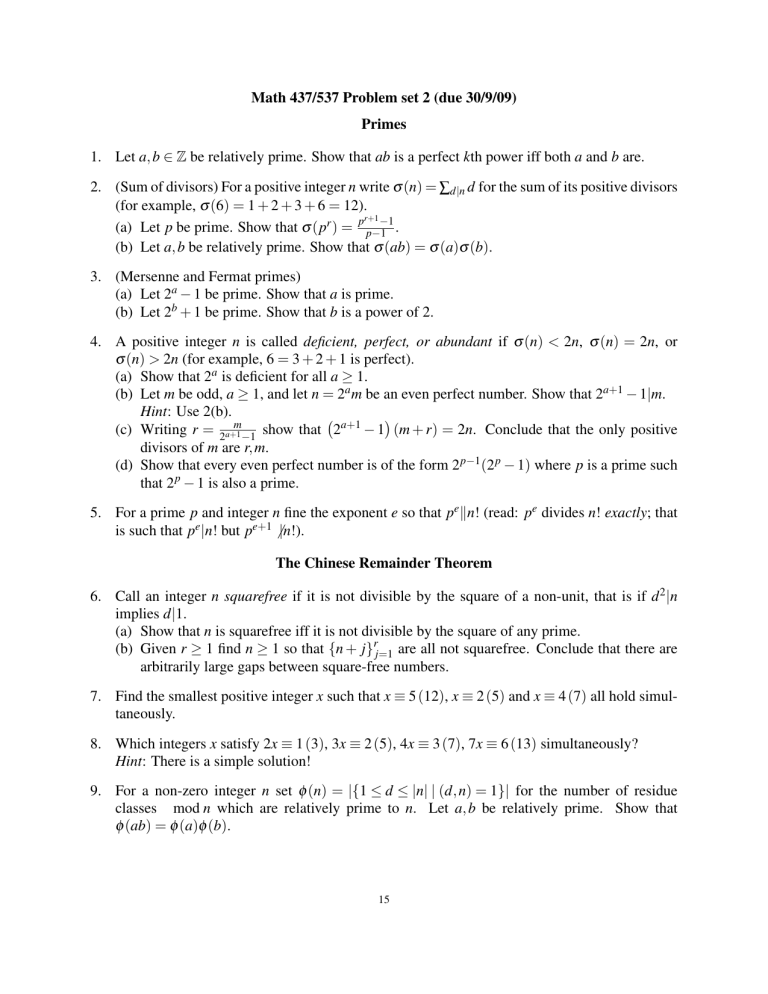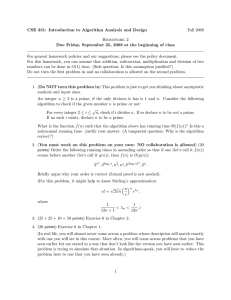Math 437/537 Problem set 2 (due 30/9/09) Primes 1.
advertisement

Math 437/537 Problem set 2 (due 30/9/09)
Primes
1. Let a, b ∈ Z be relatively prime. Show that ab is a perfect kth power iff both a and b are.
2. (Sum of divisors) For a positive integer n write σ (n) = ∑d|n d for the sum of its positive divisors
(for example, σ (6) = 1 + 2 + 3 + 6 = 12).
r+1
(a) Let p be prime. Show that σ (pr ) = p p−1−1 .
(b) Let a, b be relatively prime. Show that σ (ab) = σ (a)σ (b).
3. (Mersenne and Fermat primes)
(a) Let 2a − 1 be prime. Show that a is prime.
(b) Let 2b + 1 be prime. Show that b is a power of 2.
4. A positive integer n is called deficient, perfect, or abundant if σ (n) < 2n, σ (n) = 2n, or
σ (n) > 2n (for example, 6 = 3 + 2 + 1 is perfect).
(a) Show that 2a is deficient for all a ≥ 1.
(b) Let m be odd, a ≥ 1, and let n = 2a m be an even perfect number. Show that 2a+1 − 1|m.
Hint: Use 2(b).
(c) Writing r = 2a+1m−1 show that 2a+1 − 1 (m + r) = 2n. Conclude that the only positive
divisors of m are r, m.
(d) Show that every even perfect number is of the form 2 p−1 (2 p − 1) where p is a prime such
that 2 p − 1 is also a prime.
5. For a prime p and integer n fine the exponent e so that pe kn! (read: pe divides n! exactly; that
is such that pe |n! but pe+1 6 |n!).
The Chinese Remainder Theorem
6. Call an integer n squarefree if it is not divisible by the square of a non-unit, that is if d 2 |n
implies d|1.
(a) Show that n is squarefree iff it is not divisible by the square of any prime.
(b) Given r ≥ 1 find n ≥ 1 so that {n + j}rj=1 are all not squarefree. Conclude that there are
arbitrarily large gaps between square-free numbers.
7. Find the smallest positive integer x such that x ≡ 5 (12), x ≡ 2 (5) and x ≡ 4 (7) all hold simultaneously.
8. Which integers x satisfy 2x ≡ 1 (3), 3x ≡ 2 (5), 4x ≡ 3 (7), 7x ≡ 6 (13) simultaneously?
Hint: There is a simple solution!
9. For a non-zero integer n set φ (n) = |{1 ≤ d ≤ |n| | (d, n) = 1}| for the number of residue
classes mod n which are relatively prime to n. Let a, b be relatively prime. Show that
φ (ab) = φ (a)φ (b).
15
Congruences
10. Let (n, 7) = 1. Show that 7|n12 − 1 directly (without using induction).
11. Let a, b be (separately) relatively prime to 91. Show that a12 ≡ b12 (91).
12. (Divisibility tests I) For an integer n define Sk;10 (n) by the following procedure:
• Write n in base 10
• Divide the sequence of digits into blocks of length k, starting with the least significant
digit (the last block may be shorter).
• Sk;10 (n) is the sum of the numbers whose decimal representations are the blocks.
(a) Show S1;10 (n) ≡ n (9), and explain how to use this to test whether an integer n is divisible
by 3.
(b) Show S6;10 (n) ≡ n (7), and explain how to use this to test whether an integer n is divisible
by 7.
13. (General divisibility test) Given a base b ≥ 2 and a number d relatively prime to b find k so
that Sk;b (n) ≡ n (d). Obtain a method to test whether numbers written in base b are divisible
by d.
16









